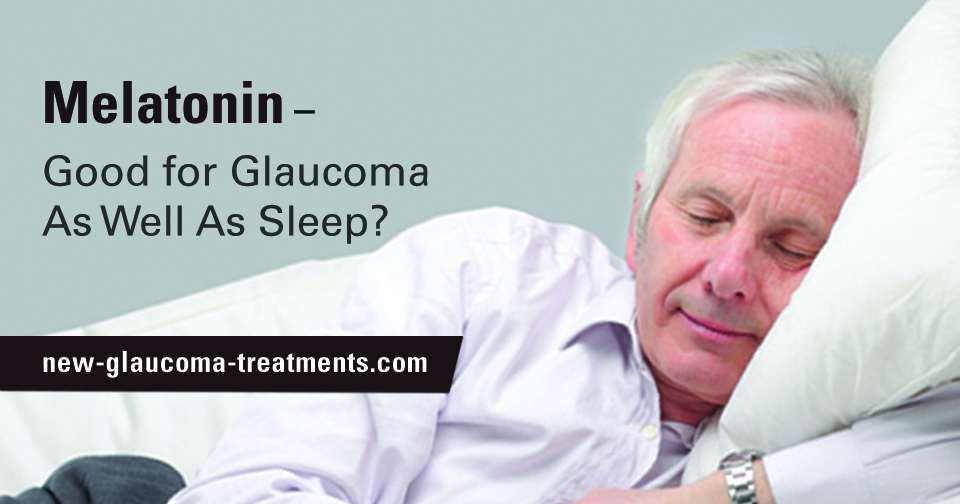
Melatonin – Good for Glaucoma as well as Sleep?
What is Melatonin?
Melatonin (scientific name: N-acetyl-5-methoxytryptamine) is a hormone naturally produced in the brain and retina.[1] It can also be found in a number of plant-based foods such as cherries,[2] walnuts,[3] tomatoes, and strawberries.[4] It has a number of functions, the best known of which is to regulate sleep.
Evidence that Melatonin can be effective in the treatment of Glaucoma
As little as 500mcg (0.5mg) of Melatonin has been shown to lower intraocular pressure (IOP) in healthy men[5]. A larger dose (10mg) was demonstrated to lower IOP when taken prior to cataract surgery.[6] This effect appears to be due to Melatonin’s actions on both the alpha and beta adrenergic receptors as well as carbonic anhydrase.[7] In essence, Melatonin acts on three of the four IOP lowering pathways currently targeted with modern prescription ocular therapy (beta-blockers, alpha-agonists, and carbonic anhydrase inhibitors).
Melatonin has other potential benefits to those with glaucoma. For example, it is a powerful antioxidant.[8] Melatonin has also been shown to provide a neuroprotective effect.[9] This neuroprotective effect appears to be enhanced when both Resveratrol and Melatonin are present.[10]
Potential Side Effects and Risks:
Melatonin has been taken in single doses as high as 500mg without notable side effects.[11] Long term, taking up to 5mg per day of Melatonin appears to be safe.[12]
Potential Drug Interactions
Anti-Hypertensive Medications
Melatonin may lower blood pressure.[13] In those whose blood pressure is not well-controlled this could be a good thing. However, care should be taken when used along with other blood-pressure lowering medications such as captopril (Capoten), enalapril (Vasotec), losartan (Cozaar), valsartan (Diovan), diltiazem (Cardizem), amlodipine (Norvasc), hydrochlorothiazide (HydroDIURIL), furosemide (Lasix), as well as many others.
Recommended Dosage
I recommend that my patients begin taking a minimum of 500mcg (0.5mg) of Melatonin thirty minutes prior to going to bed at night. If they are also having difficulty falling asleep then I will instruct them to slowly increase the dose until they have reached a maximum dose of 5mg per night. As both glaucoma and sleep disturbance are more common as we age, supplementing with Melatonin provides a dual benefit.
References
[1] Bernard M, et al. Melatonin synthesis pathway: circadian regulation of the genes encoding the key enzymes in the chicken pineal gland and retina. Reprod Nutr Dev. (1999)
[2] Burkhardt S, et al. Detection and quantification of the antioxidant melatonin in Montmorency and Balaton tart cherries (Prunus cerasus). J Agric Food Chem. (2001)
[3] Reiter RJ, Manchester LC, Tan DX. Melatonin in walnuts: influence on levels of melatonin and total antioxidant capacity of blood. Nutrition. (2005)
[4] Iriti M, Varoni EM, Vitalini S. Melatonin in traditional Mediterranean diets. J Pineal Res. (2010)
[5] Samples JR, Krause G, Lewy AJ. Effect of melatonin on intraocular pressure. Curr Eye Res. (1988)
[6] Ismail SA, Mowafi HA. Melatonin provides anxiolysis, enhances analgesia, decreases intraocular pressure, and promotes better operating conditions during cataract surgery under topical anesthesia. Anesth Analg. (2009)
[7] Crooke A, et al. Regulation of ocular adrenoceptor genes expression by 5-MCA-NAT: implications for glaucoma treatment. Pharmacogenet Genomics. (2011)
Crooke A, et al. Involvement of carbonic anhydrases in the ocular hypotensive effect of melatonin analogue 5-MCA-NAT. J Pineal Res. (2012)
[8] Zwirska-Korczala K, et al. Influence of melatonin on cell proliferation, antioxidative enzyme activities and lipid peroxidation in 3T3-L1 preadipocytes–an in vitro study. J Physiol Pharmacol. (2005)
Allegra M, et al. The chemistry of melatonin’s interaction with reactive species. J Pineal Res. (2003)
Reiter RJ, et al. Biochemical reactivity of melatonin with reactive oxygen and nitrogen species: a review of the evidence. Cell Biochem Biophys. (2001)
Poeggeler B, et al. Melatonin–a highly potent endogenous radical scavenger and electron donor: new aspects of the oxidation chemistry of this indole accessed in vitro. Ann N Y Acad Sci. (1994)
Noda Y, et al. Melatonin and its precursors scavenge nitric oxide. J Pineal Res. (1999)
Zhang H, Squadrito GL, Pryor WA. The reaction of melatonin with peroxynitrite: formation of melatonin radical cation and absence of stable nitrated products. Biochem Biophys Res Commun. (1998)
[9] Wang JZ, Wang ZF. Role of melatonin in Alzheimer-like neurodegeneration. Acta Pharmacol Sin. (2006)
[10] Kwon KJ, et al. Melatonin Potentiates the Neuroprotective Properties of Resveratrol Against Beta-Amyloid-Induced Neurodegeneration by Modulating AMP-Activated Protein Kinase Pathways. J Clin Neurol. (2010)
Kwon KJ, et al. Melatonin synergistically increases resveratrol-induced heme oxygenase-1 expression through the inhibition of ubiquitin-dependent proteasome pathway: a possible role in neuroprotection. J Pineal Res. (2011)
[11] Valcavi R, et al. Effect of oral administration of melatonin on GH responses to GRF 1-44 in normal subjects. Clin Endocrinol (Oxf). (1987)
[12] Carr R, et al. Long-term effectiveness outcome of melatonin therapy in children with treatment-resistant circadian rhythm sleep disorders. J Pineal Res. (2007)
[13] Arangino S, et al. Effects of melatonin on vascular reactivity, catecholamine levels, and blood pressure in healthy men. Am J Cardiol. (1999)
Nishiyama K, et al. Acute effects of melatonin administration on cardiovascular autonomic regulation in healthy men. Am Heart J. (2001)
Cagnacci A, et al. Influences of melatonin administration on the circulation of women. Am J Physiol. (1998)
Don’t delay getting checked for glaucoma.
Make an appointment with an eye doctor in your area now. If you live in the greater Los Angeles area and would like Dr. Richardson to evaluate your eyes for glaucoma call 626-289-7856 now. No referral required. Appointments are available, Tuesday through Saturday.


